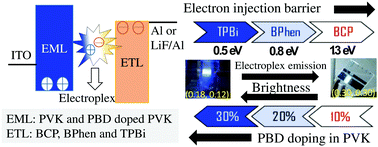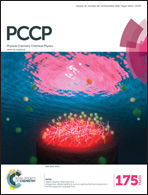White polymer light emitting diodes based on PVK: the effect of the electron injection barrier on transport properties, electroluminescence and controlling the electroplex formation
Abstract
The effects of the electron injection barrier on the charge transport, brightness and the electroluminescence (EL) properties of polymer light emitting diodes (PLEDs) with poly(9-vinylcarbazole) (PVK) as an emissive layer have been studied. By using Al and LiF/Al as the cathode in single layer PLEDs and diverse electron transporting layers (ETLs) such as 2,9-dimethyl-4,7-diphenyl-1,10-phenanthroline (BCP), 4,7-diphenyl-1,10-phenanthroline (BPhen) and 2,2′,2′′-(1,3,5-benzinetriyl)-tris(1-phenyl-1-H-benzimidazole) (TPBi) in the case of multilayer PLEDs, the charge transport, brightness, color tuning and the EL properties of the devices were drastically modified. The energy barrier for electrons affects the electron current flowing through the device, thereby affecting the operating voltage and the brightness of the PLEDs. The PLEDs with TPBi as the ETL possess the lowest injection barrier and give the maximum brightness of 426.24 cd m−2. The electron injection barrier is also found to play a major role in defining the EL spectra of the PLEDs. A larger injection barrier gives rise to electroplex formation in the EML–ETL interface of the PLEDs and an additional peak at ∼605 nm was observed in the EL spectrum. As a result, a near white emission with CIE coordinates of (0.30, 0.30) and (0.25, 0.23) at 20 V was obtained from devices with BCP and BPhen as ETLs. Furthermore, PVK doped with 2-phenyl-5-(4-biphenylyl)-1,3,4-oxadiazole (PBD) at 10, 20 and 30 wt% ratios modified the electron transport nature of PVK and had a remarkable influence on the aforesaid properties, especially on the electroplex formation.



 Please wait while we load your content...
Please wait while we load your content...